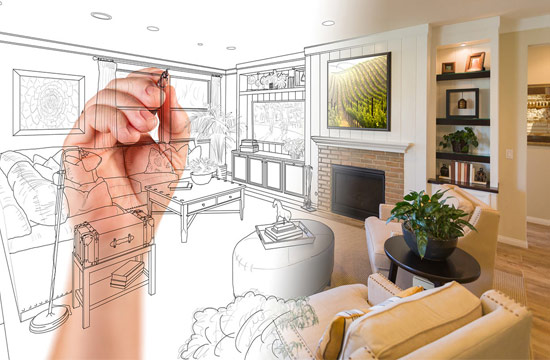How Interior Design Innovation Can Improve Hygiene
The world is grappling with COVID-19, and a definitive cure seems unlikely soon. For the time being, prevention looks like the only solution to keep the spread under control.
This pandemic has forced us to change our public and private behavior and adopt new habits. We have figured out how the virus works and how it transmits. So public touching has become a no-no and maintaining proper distance is a civic responsibility.
At the same time, it has also exposed how the design of our utility infrastructures are inadequate to fight such an outbreak. How are we going to improve hygiene if our structures are just not up to the sterilization standards? This is where innovation in the regular interior design can promote healthy behavior and reduce the contamination of spaces.

Where Can We Bring the Changes?
Throughout history, we have seen the built environment can influence behavior positively and in turn, make an impact on disease control. Interior design being part of the built environment can be used for prevention. Let’s take a look at where we can use alternative designs to stop harboring possible infectious organisms.
Natural Ventilation
We have seen how confined spaces work as infection hubs as the virus stays on for longer. Our modern offices, washrooms, lifts, and elevators all are enclosed spaces where there is little scope of outdoor air. Interior designers along with architects can put more focus on ventilation.
The flow of outside air impacts indoor humidity. Relatively higher humidity helps decrease viral infection. When it comes to apartment living, increasing air exchange and the scope of natural lighting in smaller spaces are more crucial than ever.
Choice of Materials
Likewise, the choice of material in fixtures and interior details can greatly reduce potential contagions. Easily disinfectable materials improve hygiene, where materials like stainless steel and plastic carry the virus for a longer time. Furnishing in a minimalistic way keeps the space free of clutter and attracts less dust.

Touch-less Technology
Viruses like corona spread mainly through coming into contact with respiratory droplets. Using touchless fixtures in our interior can dramatically reduce this transmission. Innovations like sensor doors at entry and exit points, touchless faucets in the washrooms are the way forward to keep a high level of cleanliness in both public and individual spaces.
For a Healthier and Aesthetically Pleasing Interior Design, Contact Interior Studio Ace
Our Service Area
Please tell us about your residential home space or commercial space requirements. One of our creative, modern interior designers or interior decorator will walk you through our service options.
- Agrabad
- Akhalia
- Amber Khana
- Anderkilla
- Anwara
- Badda
- Bagerhat
- Bagh Bari (baghbari)
- Baizid
- Bakoliya
- Balaganj
- Banani
- Banani Dohs
- Bandar
- Bandar Bazar
- Bandarban
- Banglamotor
- Bangshal
- Banskhali
- Barguna
- Baridhara
- Barisal
- Basabo
- Basundhara
- Beanibazar
- Bhola
- Bimanbondor
- Bishwanath
- Boalkhali
- Bogra
- Brahmanbaria
- Cantonment
- Cda Avenue
- Chandanaish
- Chandgaon
- Chandpur
- Chapai Nawabganj
- Chawkbazar
- Chittagong
- Chouhatta
- Chuadanga
- Colonel Hat
- Comilla
- Companiganj
- Cox's Bazar
- Dargah Mahalla
- Demra
- Dhaka
- Dhamrai
- Dhanmondi
- Dinajpur
- Dohar
- Double Mooring
- Elephant Road
- Faridpur
- Fatikchari
- Fenchuganj
- Feni
- Gaibandha
- Gazipur
- Golapgan
- Gopalganj
- Gowainghat
- Gulshan
- Habiganj
- Halishahar
- Hathazari
- Hazaribagh
- Jaintapur
- Jamalkhan
- Jamalpur
- Jatrabari
- Jessore
- Jhalokati
- Jhenaidah
- Joypurhat
- Kafrul
- Kamrangirchar
- Kanaighat
- Karnafuly
- Kawranbazar
- Keraniganj
- Khagrachhari
- Khilgaon
- Khilkhet
- Khulna
- Khulshi
- Kishoreganj
- Kotowali
- Kumar Para
- Kurigram
- Kushtia
- Lakshmipur
- Lalbag
- Lalkhan Bazar
- Lalmonirhat
- Lama Bazar
- Lohagara
- Madaripur
- Magura
- Majortila
- Malibag
- Manikganj
- Meherpur
- Mirpur
- Mirpur Dohs
- Mirsharai
- Moghbazar
- Mohakhali
- Mohakhali Dohs
- Mohammadpur
- Motijheel
- Moulvibazar
- Munshiganj
- Muradpur
- Mymensingh
- Naogaon
- Narail
- Narayanganj
- Narsingdi
- Nasirabad
- Natore
- Nawabganj
- Nayasarak
- Nehari Para
- Netrokona
- New Market
- Nilphamari
- Noakhali
- Osmani Nagar
- Pabna
- Pahartali
- Paltan
- Panchagarh
- Panchlaish
- Patenga
- Pathan Tula
- Patiya
- Patuakhali
- Pirojpur
- Purbachal
- Rajbari
- Rajshahi
- Ramna
- Rampura
- Rangamati
- Rangpur
- Rangunia
- Raozan
- Sandwip
- Satkania
- Satkhira
- Savar
- Shahi Eidgah
- Shahporan
- Shajahanpur
- Shariatpur
- Sherpur
- Shibgonj
- Sholashahar
- Sirajganj
- Sitakunda
- South Surma
- Subhani Ghat
- Subid Bazar
- Sunamganj
- Sutrapur
- Sylhet
- Tangail
- Tejgaon
- Thakurgaon
- Tongi
- Uposhohor
- Uttara
- Wari
- Zakiganj
- Zinda Bazar

